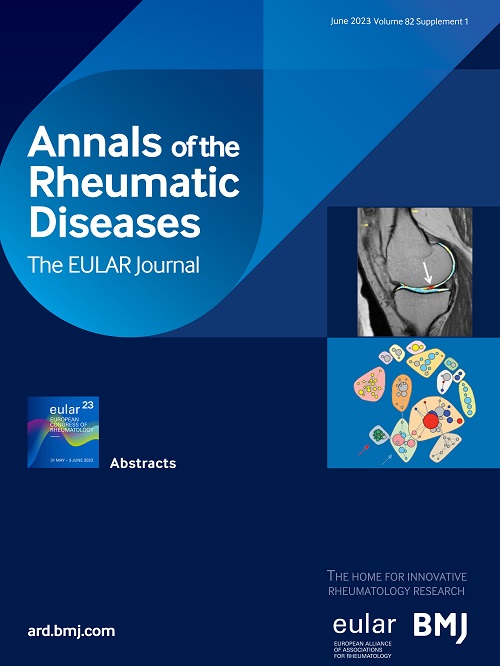Proinflammatory phenotype of B10 and B10pro cells elicited by TNF-α in rheumatoid arthritis
IF 20.3
1区 医学
Q1 RHEUMATOLOGY
引用次数: 0
Abstract
Objectives B10 and B10pro cells suppress immune responses via secreting interleukin (IL)-10. However, their regulators and underlying mechanisms, especially in human autoimmune diseases, are elusive. This study aimed to address these questions in rheumatoid arthritis (RA), one of the most common highly disabling autoimmune diseases. Methods The frequencies and functions of B10 and B10pro cells in healthy individuals and patients with RA were first analysed. The effects of proinflammatory cytokines, particularly tumour necrosis factor (TNF)-α on the quantity, stability and pathogenic phenotype of these cells, were then assessed in patients with RA before and after anti-TNF therapy. The underlying mechanisms were further investigated by scRNA-seq database reanalysis, transcriptome sequencing, TNF-α−/− and B cell-specific SHIP-1−/− mouse disease model studies. Results TNF-α was a key determinant for B10 cells. TNF-α elicited the proinflammatory feature of B10 and B10pro cells by downregulating IL-10, and upregulating interferon-γ and IL-17A. In patients with RA, B10 and B10pro cells were impaired with exacerbated proinflammatory phenotype, while anti-TNF therapy potently restored their frequencies and immunosuppressive functions, consistent with the increased B10 cells in TNF-α−/− mice. Mechanistically, TNF-α diminished B10 and B10pro cells by inhibiting their glycolysis and proliferation. TNF-α also regulated the phosphatidylinositol phosphate signalling of B10 and B10pro cells and dampened the expression of SHIP-1, a dominant phosphatidylinositol phosphatase regulator of these cells. Conclusions TNF-α provoked the proinflammatory phenotype of B10 and B10pro cells by disturbing SHIP-1 in RA, contributing to the disease development. Reinstating the immunosuppressive property of B10 and B10pro cells might represent novel therapeutic approaches for RA. All data relevant to the study are included in the article or uploaded as supplementary information.类风湿性关节炎患者在 TNF-α 作用下产生的 B10 和 B10pro 细胞促炎表型
目标 B10 和 B10pro 细胞通过分泌白细胞介素(IL)-10 抑制免疫反应。然而,它们的调节因子和内在机制,尤其是在人类自身免疫性疾病中的调节因子和内在机制,仍然难以捉摸。本研究旨在解决类风湿性关节炎(RA)中的这些问题,RA 是最常见的高致残性自身免疫性疾病之一。方法 首先分析了健康人和 RA 患者体内 B10 和 B10pro 细胞的频率和功能。然后评估了促炎细胞因子,特别是肿瘤坏死因子(TNF)-α 对这些细胞的数量、稳定性和致病表型的影响。通过scRNA-seq数据库再分析、转录组测序、TNF-α-/-和B细胞特异性SHIP-1-/-小鼠疾病模型研究,进一步研究了其潜在机制。结果 TNF-α 是 B10 细胞的关键决定因素。TNF-α 通过下调 IL-10、上调干扰素-γ 和 IL-17A 来激发 B10 和 B10pro 细胞的促炎特性。在RA患者中,B10和B10pro细胞受损并具有加剧的促炎表型,而抗TNF疗法能有效恢复它们的频率和免疫抑制功能,这与TNF-α-/-小鼠中增加的B10细胞一致。从机理上讲,TNF-α通过抑制糖酵解和增殖来减少B10和B10pro细胞。TNF-α还能调节B10和B10pro细胞的磷脂酰肌醇磷酸信号,并抑制SHIP-1的表达,SHIP-1是这些细胞的主要磷脂酰肌醇磷酸酶调节因子。结论 TNF-α 在 RA 中通过干扰 SHIP-1 引发 B10 和 B10pro 细胞的促炎表型,导致疾病发展。恢复B10和B10pro细胞的免疫抑制特性可能是治疗RA的新方法。与该研究相关的所有数据均包含在文章中或作为补充信息上传。
本文章由计算机程序翻译,如有差异,请以英文原文为准。
求助全文
约1分钟内获得全文
求助全文
来源期刊

Annals of the Rheumatic Diseases
医学-风湿病学
CiteScore
35.00
自引率
9.90%
发文量
3728
审稿时长
1.4 months
期刊介绍:
Annals of the Rheumatic Diseases (ARD) is an international peer-reviewed journal covering all aspects of rheumatology, which includes the full spectrum of musculoskeletal conditions, arthritic disease, and connective tissue disorders. ARD publishes basic, clinical, and translational scientific research, including the most important recommendations for the management of various conditions.
 求助内容:
求助内容: 应助结果提醒方式:
应助结果提醒方式:


